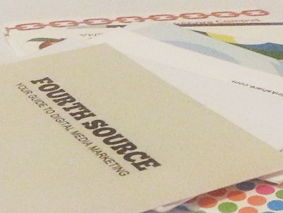The business card is the single most successful networking tool of all time. Why? Because it’s simple, yet effective.
From as early as the 15th century, cards have been used as a form of advertising oneself with ‘visiting cards’ popular in both China and Japan for announcing the intention of a meeting with another individual.
Today, the business card is an internationally recognised method of exchanging contact information, with tens of billions cards printed worldwide every year.
In the age of social networks, you’d be forgiven for questioning the relevancy of a physical business card. You’ve no doubt seen the headlines proclaiming the death of print in the digital age.
But actually, as our lives have become more virtualised, the business card has gained an increasing importance in the real world and is more relevant than it ever was.
An individual’s success or failure in business can depend on the strength of their personal promotion. The business card as a marketing tool may seem a little old-fashioned, especially when there’s the potential to connect quickly and easily with millions on LinkedIn, Facebook or Twitter.
But it’s incredibly hard to stand out among the crowd of LinkedIn’s 187 million (and counting) members. To others, you’re just another URL or email address.
By meeting people and speaking to them you get to say a lot more about yourself and a great business card can speak volumes about its owner. It does something that data can’t – it’s a tangible way of saying, ‘this is me’.
Through great design you can bring personality to your business and help it stand out. And you don’t have to be a multinational with a million-pound marketing budget to get you yourself noticed.
I don’t think any fancy campaign can match the power and simplicity of handing over a well-designed card.
Don’t just take my word for it. According to some of the UK’s smartest entrepreneurs, when it comes to marketing, good old-fashioned methods work best.
In a survey we recently conducted, 21 per cent of the UK’s small and medium-sized businesses claim their business cards are their most important marketing tool and can help their ventures grow.
For small companies, every new business relationship matters. It’s why 42 per cent of our survey respondents believe that if they were to hand out 100 business cards, it would generate £5,000 a year or more in revenue.
The secret to success in this tough economic climate is maintaining strong offline and online presences and making the most of every tool at your disposal.
Use social networking on sites like Facebook and LinkedIn to stay in touch with a wider audience, and use these tools and others, like Twitter, to maintain a business presence online.
But extend your identity offline as well – combine these tools with offline marketing and you can create a unique way of sharing your contact details, and other online profile information, with friends in the real world.
Having a physical representation of your online identity means your business card can become more than just a way to exchange your contact details, it helps you tell your story.
You could use your Flickr photos or your Facebook timeline to turn your dynamic online presence into an offline ‘social’ business card.
Or in the future, we could see business cards embedded with tiny microchips that a smartphone can read to pull information from the web – whether it’s your portfolio or simply more up-do-date contact details. Your business card becomes a digital identity that you can share from anywhere.
The lines between online social networking and offline business networking are disappearing. But what’s clear is that a good business card should be one that is best friends with the web.
As technology evolves, the future of the business card can only be bright.






